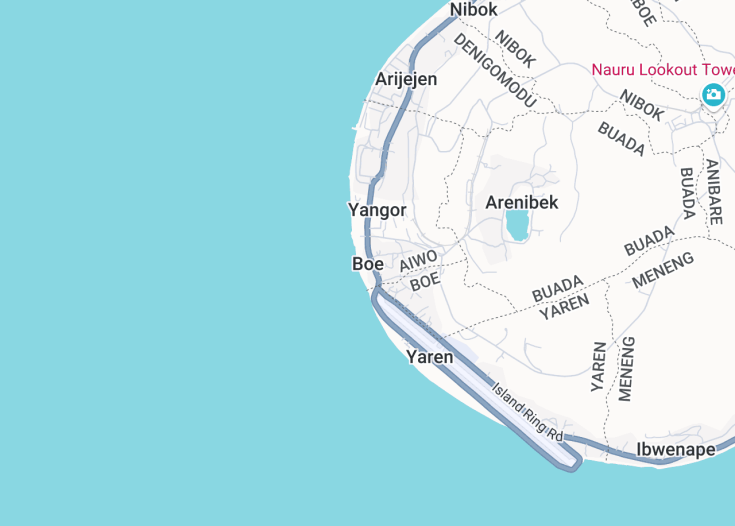Boe is a unique highlight in the island nation of Nauru, offering a distinctive blend of cultural and natural attractions. Despite being one of the smallest districts, Boe is historically significant, known as the location where Nauru’s independence was declared in 1968. Visitors to Boe can explore its lush tropical landscape, traditional architecture, and the remnants of phosphate mining operations. The community here is known for its warmth and hospitality, providing an intimate glimpse into the life and traditions of Nauruan society.
When visiting Boe, make sure to attend a local cultural event or festival to truly appreciate the rich Nauruan heritage and community spirit. It’s a wonderful opportunity to connect with the locals.
Plan your visit to Boe during the cooler, dry season from May to October for the most comfortable climate and optimal experience exploring the outdoors and historical sites.
Top things to do & see in Boe
Select the following sights and activities to discover best tickets and tours available in Boe.
Boe: A Hidden Gem in the Pacific
| Country | Nauru |
| Time in Boe | GMT+12 |
| Language spoken | Nauruan |
| Population | 851 (2023 Census) |
| Currency | Australian Dollar (AUD) |
| Airports | Nauru International Airport (6 mi / 9.65 km) |
Located in the southwestern part of Nauru, Boe is one of the smallest and least populous districts yet holds historical significance and charm. Boe is renowned for its rich cultural history, from ancient times as a pivotal communal region to its modern-day stature as a symbol of resilience and tradition. The combination of natural beauty and cultural heritage makes Boe a distinct part of Nauru.
As a pivotal area in Nauru’s history, Boe was originally the location where the island’s constitution was signed, making it an essential site of national heritage. Additionally, like many areas in Nauru, Boe has been influenced by phosphate mining though it retains much of its natural landscape compared to busier districts.
Visitors to Boe can witness Nauru’s traditions alive in the everyday life of its citizens, from local handicrafts to the hospitality extended to guests. The close-knit community in Boe offers an intimate look at the Nauruan way of life, where ancient customs and modern resilience blend seamlessly.
Where is Boe?
Boe is situated on the island of Nauru, in the southwestern region facing the Pacific Ocean.
Distances:
| Route | Distance by car | Time by car |
|---|---|---|
| Yaren to Boe | 3 miles | 5 minutes |
| Anibare to Boe | 5 miles | 7 minutes |
What is Boe famous for?
Boe is notably famous for being the symbolic birthplace of Nauru’s modern governance, as it was here that Nauru’s constitution was signed on January 31, 1968.
History
Prehistoric Era to Early 20th Century
The history of Boe, a district located on the island of Nauru, stretches back thousands of years, marked by the first settlers who are believed to have arrived from Micronesia around 1000 BC. These early inhabitants developed a distinct Nauruan culture, characterized by its unique language and traditions. Over the centuries, Nauruans lived in tribal communities, with Boe emerging as one of the distinct tribal areas.
Colonial Era (1888-1968)
The late 19th and early 20th centuries brought significant changes with the arrival of European colonizers and traders. In 1888, Germany annexed Nauru, including Boe, introducing Western influences and Christianity. Following World War I, Nauru became a mandate territory under the League of Nations, administered by Australia, New Zealand, and the United Kingdom. This period saw the beginning of phosphate mining, dramatically transforming the island’s landscape and economy.
Post-Independence Era (1968-Present)
Nauru gained independence in 1968, and Boe has since been part of a sovereign nation. The district has played a significant role in the country’s political landscape, notably with the election of Nauru’s first female president, who hailed from Boe, in 2016. Despite facing challenges such as economic fluctuations and environmental degradation due to intensive phosphate mining, Boe continues to be a central hub of Nauru’s cultural and political life. Today, efforts are being made to diversify the economy and promote sustainable development within the district.
Visit Boe
What to see and do in Boe, Nauru
Boe offers a unique insight into the serene and traditional lifestyle of Nauru. Visitors can explore local landmarks such as the Nauru Phosphate Corporation, which tells the history of the island’s economic backbone. For nature enthusiasts, the lush tropical vegetation around Boe provides a perfect backdrop for hiking and bird watching. The coastline offers breathtaking views of the Pacific Ocean, ideal for sunrise and sunset walks.
- Visit the Nauru Phosphate Corporation for a glimpse into the island’s industrial past
- Enjoy nature walks through tropical vegetation
- Relax by the coast and experience stunning oceanic sunrises and sunsets
Annual Events in Boe
Boe and the wider Nauruan community celebrate various cultural and national events throughout the year. Notably, Angam Day, celebrated on October 26th, commemorates the resurgence of the Nauruan population to 1,500, considered a sustainable number post-depletion from phosphate mining and World War II hardships. There’s also the Independence Day celebrations every January 31st, showcasing traditional music, dance, and food.
Best time to visit Boe
The best time to visit Boe in Nauru is during the cooler dry months from May to October. This period offers more comfortable weather conditions for exploring outdoor attractions and participating in local events.
Is Boe worth visiting?
Boe, Nauru, offers a distinctive travel experience with its rich history and cultural significance. The district’s natural beauty and serene environment make it appealing for those seeking a quiet retreat. However, visitors should be aware of the limited tourist infrastructure and the impacts of phosphate mining, which might be a challenge. Nonetheless, for travelers interested in the Pacific Islands’ unique cultural and historical aspects, Boe presents an interesting destination.









